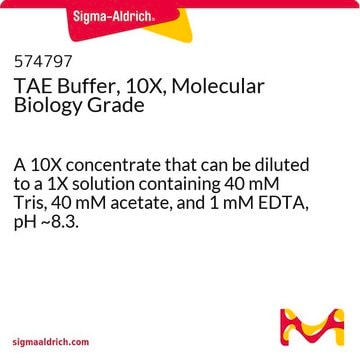PPB008
Tris Acetate-EDTA buffer
pH 8.3, pHast Pack™, powder
Sinónimos:
1X TAE buffer, TAE, Tris Acetate EDTA, TAE buffer
About This Item
Productos recomendados
product line
pHast Pack™
form
powder
pH
8.3
suitability
suitable for gel electrophoresis (after dilution to working concentration)
suitable for gel electrophoresis
foreign activity
DNAse, none detected
Nickase, none detected
Protease, none detected
RNAse, none detected
SMILES string
CC(O)=O.NC(CO)(CO)CO.OC(=O)CN(CCN(CC(O)=O)CC(O)=O)CC(O)=O
InChI
1S/C10H16N2O8.C4H11NO3.C2H4O2/c13-7(14)3-11(4-8(15)16)1-2-12(5-9(17)18)6-10(19)20;5-4(1-6,2-7)3-8;1-2(3)4/h1-6H2,(H,13,14)(H,15,16)(H,17,18)(H,19,20);6-8H,1-3,5H2;1H3,(H,3,4)
InChI key
HGEVZDLYZYVYHD-UHFFFAOYSA-N
¿Está buscando productos similares? Visita Guía de comparación de productos
Categorías relacionadas
General description
Application
- DNA agarose gel electrophoresis
- Non-denaturing RNA agarose gel electrophoresis for RNA >1500 bases
- Denaturing gradient gel electrophoresis
- Northern and Southern blotting
Features and Benefits
- Ready for use – saves time and effort
- No measuring and pH adjusting needed
- Eliminate exposure to toxic chemicals to prepare buffers
- Biological tests: free of DNase, RNase, Protease, and Nickase
- Chemical tests: Iron ≤10 ppm, lead ≤5 ppm
Packaging
Preparation Note
Reconstitution
Storage and Stability
Other Notes
Legal Information
Storage Class
11 - Combustible Solids
wgk_germany
WGK 3
flash_point_f
Not applicable
flash_point_c
Not applicable
Choose from one of the most recent versions:
Certificados de análisis (COA)
Don't see the Right Version?
If you require a particular version, you can look up a specific certificate by the Lot or Batch number.
¿Ya tiene este producto?
Encuentre la documentación para los productos que ha comprado recientemente en la Biblioteca de documentos.
Nuestro equipo de científicos tiene experiencia en todas las áreas de investigación: Ciencias de la vida, Ciencia de los materiales, Síntesis química, Cromatografía, Analítica y muchas otras.
Póngase en contacto con el Servicio técnico





